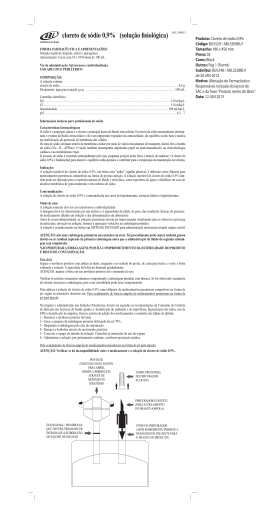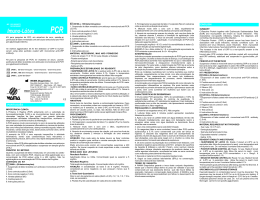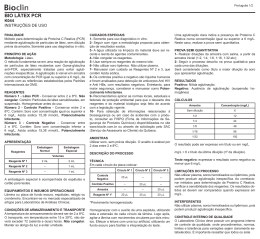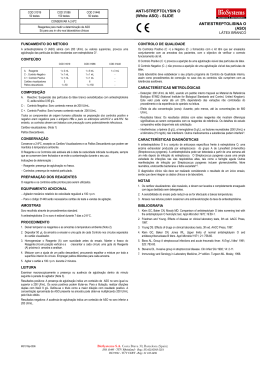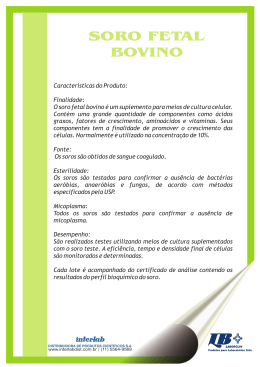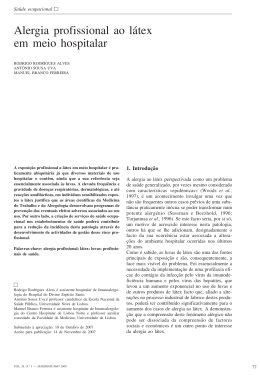MS 10310030069 10310030090* Imuno-Látex ASLO Kit para pesquisa de antiestreptolisina O em amostras de soro, usando-se partículas de látex revestidas com estreptolisina O por aglutinação indireta. An indirect agglutination kit for the detection of anti-streptolysin-O in human serum using latex particles coated with streptolysing-O. Kit para la pesquisa de antiestreptolisina O en muestra de suero, usando particulas de látex revestidas con estreptolisina O por aglutinación indirecta. REF 21060-L: 60 determinações / determinations / determinaciones REF 210100-L: 100 determinações / determinations / determinaciones REF 21000-L: 2,5 ml de Látex* WAMA Diagnóstica EC R E P Rua Aldo Germano Klein, 100 - CEAT CEP 13560-971 - São Carlos - SP Fone 55 16 3377.9977 / Fax 55 16 3377.9970 www.wamadiagnostica.com.br Obelis S.A. Boulevard Général Wahis 53 1030 Brussels, BELGIUM Phone. +(32) 2 732-59 54 Fax : +(32) 2 732-60 03 www.obelis.net PORTUGUÊS IMPORTÂNCIA CLÍNICA A estreptolisina O, produzida por quase todas as cepas de Streptococus pyogenes, é uma hemolisina oxigênio-lábil (inativada pelo oxigênio), com potente antigenicidade. O anticorpo formulado contra ela, o antiestreptolisina O, tem se tornado o indicador de infecções estreptocócicas e suas complicações, tais como a febre reumática e a glomerulonefrite aguda. A concentração de anticorpos antiestreptolisina O aumenta no final da primeira semana após a infecção estreptocócica e atinge seu valor máximo entre a 3ª e 5ª semanas, retornando, na maioria dos casos, ao nível normal do segundo ao quarto mês. PRINCÍPIO DO MÉTODO Partículas de látex revestidas com estreptolisina O, purificadas e estabilizadas mostram nítida aglutinação quando misturadas, em uma área do cartão-teste, com um soro contendo níveis elevados de anticorpos antiestreptolisina. CONTEÚDO DO KIT R E F 21060-L (60 determinações) 1. Suspensão de látex revestida com estreptolisina O (1,5ml) 2. Soro controle positivo (0,5ml) 3. Soro controle negativo (1ml) 4. Varetas plásticas (60) 5. Cartões-teste (2) 6. Instruções para uso R E F 210100-L (100 determinações) 1. Suspensão de látex revestida com estreptolisina O (2,5ml) 2. Soro controle positivo (0,5ml) 3. Soro controle negativo (1ml) 4. Varetas plásticas (100) 5. Cartões-teste (2) 6. Instruções para uso R E F 21000-L (2,5ml de Látex) 1. Suspensão de látex revestida com estreptolisina O (2,5ml) 2. Instruções para uso. MATERIAL NECESSÁRIO, MAS NÃO FORNECIDO • Tubos de ensaio para diluição e titulação • Estante para tubos e rack de ponteiras • Pipetas sorológicas • Recipiente para descarte do material • Salina a 0,9% PREPARAÇÃO E ESTABILIDADE DOS REAGENTES • SUSPENSÃO DE LÁTEX (1): é estável entre 2-8ºC até a data do vencimento. Contém azida sódica 0,1%. Deixar em temperatura ambiente antes de utilizar. Homogeneizar bem antes de usar. Não congelar. • SORO CONTROLE POSITIVO (2): pronto para uso. É estável entre 2-8ºC até a data do vencimento. Contém azida sódica 0,1%. Deixar em temperatura ambiente antes de usar. Concentração de antiestreptolisina O: maior ou igual a 200UI/ml. • SORO CONTROLE NEGATIVO (3): pronto para uso. É estável entre 2-8ºC até a data do vencimento. Contém azida sódica 0,1%. Deixar em temperatura ambiente antes de usar. Obs. O kit mantém o mesmo desempenho após a primeira utilização, e é estável até a data de validade descrita no rótulo, desde que mantido na temperatura indicada (2 - 8ºC) AMOSTRAS Soros livres de hemólise, lipemia e contaminação bacteriana. Caso necessário, as amostras podem ser conservadas no freezer a -20ºC, por no máximo 6 semanas, ou entre 2-8ºC por 48 horas. Os soros devem ser usados puros, ou seja, não diluídos. Não se deve usar plasma porque o fibrinogênio pode causar aglutinação inespecífica. PROCEDIMENTO a. Teste Qualitativo 1. Pipetar 25µl do soro do paciente em uma área do cartão-teste. 2. Homogeneizar a suspensão de látex (1) e pipetar 25µl na mesma área da amostra. 3. Misturar muito bem o soro com o látex, espalhando-se cuidadosamente com uma vareta plástica. 4. Através de movimentos suaves de rotação, sob uma boa fonte de luz, observar durante 2 minutos a formação de uma eventual aglutinação. ATENÇÃO: Para cada série de testes devem se fazer controles positivo e negativo para verificar a correta execução da técnica e o estado de conservação dos reagentes. Efeito pró-zona pode ocorrer em concentrações superiores a 1500UI/ml. Se houver suspeita de níveis superiores a este, a amostra deverá ser diluída. RESULTADO DAS LEITURAS Resultado Positivo: Aglutinação tênue ou nítida. Concentração igual ou superior a 200Ul/ml. Resultado Negativo: Total ausência de aglutinação. Concentração inferior a 200Ul/ml. ATENÇÃO: A sensibilidade do teste foi ajustada para detectar 200Ul/ml. Portanto, consideram-se soros negativos os que possuam menos que 200Ul/ml. b. Teste Semi-Quantitativo 1. Diluir o soro do paciente em salina (NaCl a 0,9%) 1:2, 1:4, 1:8, 1:16 e mais se necessário. 2. Pipetar 25µl de cada diluição em cada área do cartão-teste. 3. Homogeneizar a suspensão de látex (1) e pipetar 25µl em cada área onde se encontra a diluição da amostra. 4. Misturar muito bem o soro com o látex, espalhando-se cuidadosamente com uma vareta plástica (uma para cada diluição). 5. Através de movimentos suaves de rotação, sob uma boa fonte de luz, observar durante 2 minutos a formação de aglutinação (vide resultado das leituras). O título da amostra corresponderá a maior diluição em que ocorrer aglutinação. A concentração de ASLO será dada pelo seguinte cálculo: Concentração (Ul/ml) = 200 x D, onde 200 é a sensibilidade do teste e D, a maior diluição que apresenta aglutinação. EXEMPLO: Se o título obtido for 1:8, a concentração aproximada de ASLO existente na amostra será: 200x8 = 1600Ul/ml. INTERPRETAÇÃO Os valores normais de ASLO variam com a idade do indíviduo. Geralmente encontram-se abaixo de 250Ul/ml. Entretanto, na prática, muitos estudiosos do assunto consideram como normais os valores de 333Ul/ml até 5 anos de idade, e até 500Ul/ml acima dos 5 anos de idade. É importante considerar que a ASLO não expressa atividade de doença. Não há relação direta entre elevação e normalização de títulos com a gravidade de febre reumática. Existe a possibilidade da ASLO manter-se elevada e com valores mais ou menos fixos por meses, sem causa aparente, mesmo com provas de atividades inflamatórias normais. A instituição precoce de antibióticos e corticosteróides até 12 a 15 dias após a infecção estreptocócica poderá diminuir a resposta imunológica do indivíduo, com conseqüentes baixos títulos de ASLO. Embora considerado como um importante teste, a ASLO representa apenas uma resposta a uma prévia infecção estreptocócica e a sua elevação não significa um reumatismo. PRECAUÇÕES E ADVERTÊNCIAS 1. Conservar os reagentes entre 2-8ºC. Não congelar. 2. Leituras feitas após 2 minutos podem apresentar resultado falsamente positivo. 3. Após o uso, lavar os cartões-teste com água destilada. Se isto não for efetuado imediatamente, usar água com detergente neutro e enxagüar várias vezes com água destilada ou deionizada. Secar antes de usar novamente, resíduos de detergentes podem provocar resultados falsamente positivos.. 4. Usar uma vareta plástica para cada determinação. 5. Os reagentes (látex e soros controles) Imuno-Látex ASLO contém azida-sódica a 0,1% como conservante que pode ser tóxica se ingerida. O descarte dos reagentes deve ser acompanhado de grandes volumes de água para evitar o acúmulo de resíduos de azida nas tubulações, pois esta pode reagir com o chumbo ou cobre dos encanamentos, formando sais altamente explosivos. 6. Os soros usados na preparação dos controles foram testados, com resultados negativos para anticorpo anti-HCV, antígeno de superfície da hepatite B (HBsAg) e anti-HIV. Porém, como nenhum método diagnóstico oferece completa segurança na ausência destes e de outros agentes infecciosos, recomenda-se tratar os soros controles como materiais potencialmente infecciosos. 7. Descarte o material conforme regulamentações locais. 8. Seguir as boas práticas laboratoriais (BPLs) na conservação, manuseio e descarte dos materiais. TERMO DE GARANTIA A WAMA Diagnóstica garante a troca deste conjunto diagnóstico, desde que o mesmo esteja dentro do prazo de validade e que seja comprovado por sua assessoria técnica que não houve falhas na execução, manuseio e conservação deste produto. A WAMA e seus distribuidores não se responsabilizam por falhas no desempenho do kit sob essas condições. ENGLISH SUMMARY Streptolysin-O, produced by almost all strains of Streptococucs pyogenes, is an haemolysin oxygen- labile (inactivated by oxygen) and it is highly antigenic. Streptolysin-O has antigenic activity which results in the production of antibodies known as anti-streptolysin-O. These antibodies have been universally accepted as diagnostic procedure in streptococcal infections such as rheumatic fever and acute glomerulonephritis. Anti-streptolysin-O antibodies concentration increases at the end of the first week after streptococcal infection and reaches its highest value between third and fifth weeks. The concentration has its normal values from second to fourth month. PRINCIPLE OF THE METHOD Latex particles purified and stabilised coated with streptolysin-O show clear agglutination when mixed, in a test card, with serum containing high levels of anti-streptolysin antibodies. KIT PRESENTATION R E F 21060-L (60 determinations) 1. Suspension of latex coated with streptolysin-O (1,5ml) 2. Positive control serum (0,5ml) 3. Negative control serum (1ml) 4. Stirrers (60) 5. Test cards (2) 6. Instructions for use R E F 210100-L (100 determinations) 1. Suspension of latex coated with streptolysin-O (2,5ml) 2. Positive control serum (0,5ml) 3. Negative control serum(1ml) 4. Stirrers (100) 5. Test cards (2) 6. Instructions for use R E F 21000-L (2.5ml Latex) 1. Suspension of latex coated with streptolysin-O (2.5ml) 2. Instructions for use MATERIAL REQUIRED BUT NOT PROVIDED • Test tubes • Test tube shelf rack for tips • Serological pipettes • Disposable material container • Saline 0,9% REAGENT STABILITY AND STORAGE • SUSPENSION OF LATEX (1): Stable if stored at 2-8ºC up to expiration date. Allow the latex to reach room temperature and mix it prior to use. Do not freeze. It contains Sodum azide 0.1%. • POSITIVE CONTROL SERUM (2): Ready for use. Stable if stored at 2-8ºC up to expiration date. Allow the control to reach room temperature prior to use. Anti-streptolysin-O concentration: > or = 200IU/ml. It contains Sodium azide 0.1%. • NEGATIVE SERUM CONTROL (3): Ready for use. Stable if stored at 2-8ºC up to expiration date. Allow the control to reach room temperature prior to use. It contains Sodium azide 0.1%. The kit presents good performance after being used for the first time. It is stable up to the expiration date if store at 2 - 8ºC. SPECIMEN COLLECTION AND STORAGE Hemolytic, lipaemic or contaminated serum must be discarded. Specimen may be stored at 2-8ºC for up to 48 hours prior testing. If longer storage is required, store in freezer at - 20ºC for up to 6 weeks. Do not use diluted serum. Do not use plasma since fibrinogen can form non-specific agglutination. PROCEDURE A. Qualitative test 1. Pipette 25µl of patien’s serum in the area of test card. 2. Gently shake the suspension of latex (1) and pipette 25µl in the same area of test card. 3.Using the stirrers, mix the serum dilution and the latex and spread them over the entire circle. 4.Rotate the test card for 2 minutes and observe the agglutination while holding the slide under a good source of light. ATENTION: Positive and negative controls should be included at regular intervals in order to check the procedure and reagents. Prozone effect can be present in concentrations higher than 1500IU/ml. If it is the case, the specimen should be diluted. READING Positive: Clear agglutination is seen. Concentration equal or > 200IU/ml. Negative: No agglutination is seen. Concentration <200IU/ml. ATENTION: The sensitivity was adjusted to detect 200IU/ml. Therefore, negative serum is lower than 200IU/ml. B. Semi-Quantitative test 1. Using saline (NaCl 0.9%) prepare serial dilutions of the patient’s serum at 1:2, 1:4, 1:8, 1:16 and so on. 2. Pipette 25µl of each dilution in each area of test card. 3. Mix the suspension of latex (1) and pipette 25µl in each area where the sample dilution is present. 4. Using the stirrer, mix the serum dilution with latex and spread over the entire circle (Use a separate stirrer for each dilution). 5. Rotate the test card for 2 minutes and observe the agglutination while holding the slide under a good source of light. (See Reading). The highest serum dilution showing a definite agglutination pattern is considered the titer end point. ASO concentration is calculated as follow: Concentration(IU/ml) = 200 x D, where 200 is the sensitivity of test and D is the highest dilution showing agglutination. EXAMPLE: If the titer is 1:8, concentration of ASO on the specimen is: 200x8 = 1600IU/ml. INTERPRETATION ASO normal values can vary with the age of the person. Normally this value is below 250IU/ml. Specialists consider 333IU/ml as normal values up to 5 years of old and up to 500 IU/ml values above 5 years of old. It is important to highlight that ASO does not produce much information about the current state of the disease.The levels of the titers and severity of the symptoms are not necessarily parallel. ASO levels can remain high with fixed values for months even with normal degrees of infection. Early intake of antibiotics and corticosteroid up to 12 to 15 days after streptococcal infection may decrease the immunological response and consequently show ASO with low titers. Although ASO is regarded as an important test, it is only a previous response to streptococcal infection and it is not a cause of rheumatism. PRECAUTIONS AND WARNINGS 1. Store the reagents at 2-8ºC. Do not freeze. 2.Read the results after 2 minutes can cause false positive results. 3. At the end of the test, wash the test card with distilled water. If prefer to wash later, use water with a neutral detergent and rinse out slightly with distilled or deionized water. Dry prior to use. Vestigium of detergent may affect the results by causing false positive results. 4. Use separate stirrer for each sample. 5. Imuno Látex ASLO (latex and controls) contain 0.1% sodium azide as a preservative which may be toxic if ingested. Sodium ESPAÑOL REF REF REF BIBLIOGRAFÍA 1. Cohen, A.S.: Diagnostico de laboratorio en las enfermidades reumaticas. Salvat Editore, 2° ed., 1982. 2. Cruz Filhoi, A.: Clinica Reumatologica, Editora Guanabara Koogan, 1980. 3. Koepke, J.R.: Rheumatic fever in Children: Criteria for Diagnosis. Labmedica, 4:15, 1990. 4. Rantz, L.A. and Randall, E.: A modification of the technic for determination of antistreptolysin titer. Proc. Soc. Experim. Bio.Méd., 59:22-25, 1945. 5. Spaun, J. et al.: international standard for antistreptolysin O. Bull. W.H.O, 1961. 6. Wannamaker, L.W. and Ayoub, E.M.: Antibody titers in acute rheumatic fever. Circulation, 21:598, 1960. SIMBOLOGIA / SIMBOLS / SIMBOLOGIA IVD O conteúdo é suficiente para (n) testes Quantity sufficient for (n) tests O contenido es suficiente para (n) testes LOT Número do lote Lot Number Número del lote Data limite de utilização Expiry Date Fecha de la caducidad REF Número do catálogo Catalog Number Número del catálogo Produto diagnóstico in vitro In vitro diagnostic Produto diagnóstico in vitro Limite de temperatura Temperature Limite de temperatura Consultar instruções para uso Refer to user's instructions Consultar las instrucciones para el uso Proteger do calor Keep away from sunlight Proteger del calor Representante Europeu Fabricado por Manufactured by Fabricado por EC R E P European Representative Representante Europeu VI Edição: Rev. 02/2011
Download
